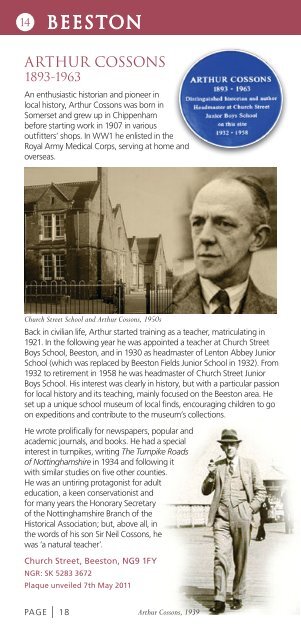GUIDE TO THE BLUE PLAQUES
BP%20final%20proof.2016.05.03
BP%20final%20proof.2016.05.03
Create successful ePaper yourself
Turn your PDF publications into a flip-book with our unique Google optimized e-Paper software.
14<br />
BEES<strong>TO</strong>N<br />
BEES<strong>TO</strong>N 15<br />
ARTHUR COSSONS<br />
1893-1963<br />
An enthusiastic historian and pioneer in<br />
local history, Arthur Cossons was born in<br />
Somerset and grew up in Chippenham<br />
before starting work in 1907 in various<br />
outfitters’ shops. In WW1 he enlisted in the<br />
Royal Army Medical Corps, serving at home and<br />
overseas.<br />
VILLAGE CROSS<br />
Also on Church Street, close<br />
to plaque 14 and within the<br />
West End Conservation Area,<br />
this ancient stone possibly<br />
dates from the Middle Ages<br />
and is believed by some to be<br />
the shaft of Beeston’s medieval<br />
village cross. It once stood near<br />
the present junction of Church Street, Dovecote Lane, West End<br />
(plaque 17) and Middle Street, close to where the war memorial<br />
now stands. Thus it was at the centre of the old village, with the<br />
Manor House (plaque 16) and parish church nearby.<br />
Church Street School and Arthur Cossons, 1950s<br />
Back in civilian life, Arthur started training as a teacher, matriculating in<br />
1921. In the following year he was appointed a teacher at Church Street<br />
Boys School, Beeston, and in 1930 as headmaster of Lenton Abbey Junior<br />
School (which was replaced by Beeston Fields Junior School in 1932). From<br />
1932 to retirement in 1958 he was headmaster of Church Street Junior<br />
Boys School. His interest was clearly in history, but with a particular passion<br />
for local history and its teaching, mainly focused on the Beeston area. He<br />
set up a unique school museum of local finds, encouraging children to go<br />
on expeditions and contribute to the museum’s collections.<br />
He wrote prolifically for newspapers, popular and<br />
academic journals, and books. He had a special<br />
interest in turnpikes, writing The Turnpike Roads<br />
of Nottinghamshire in 1934 and following it<br />
with similar studies on five other counties.<br />
He was an untiring protagonist for adult<br />
education, a keen conservationist and<br />
for many years the Honorary Secretary<br />
of the Nottinghamshire Branch of the<br />
Historical Association; but, above all, in<br />
the words of his son Sir Neil Cossons, he<br />
was ‘a natural teacher’.<br />
Church Street, Beeston, NG9 1FY<br />
NGR: SK 5283 3672<br />
Plaque unveiled 7th May 2011<br />
Site of the cross, early 1900s<br />
The cross was removed in the 1850s and was lost, but in 1929 the<br />
shaft was found embedded in a wall at Manor Lodge by historian<br />
Arthur Cossons (plaque 14). As headmaster at Church Street<br />
Junior Boys School (demolished 2005), it was appropriate that he<br />
had it re-erected close to this school.<br />
The village cross has sometimes been<br />
referred to as a market cross, as it<br />
is believed that a corn market was<br />
formerly held nearby. Middle Street,<br />
from the war memorial to Station<br />
Road (formerly Brown Lane), was<br />
known as Market Street until the<br />
late 1860s. The historical value<br />
of the shaft is recognised by its<br />
Grade II listing.<br />
Church Street,<br />
Beeston, NG9 1FY<br />
NGR: SK 5282 3674<br />
Plaque unveiled<br />
7th May 2011<br />
PAGE | 18<br />
Arthur Cossons, 1939<br />
Remaining shaft in 1976<br />
PAGE | 19


